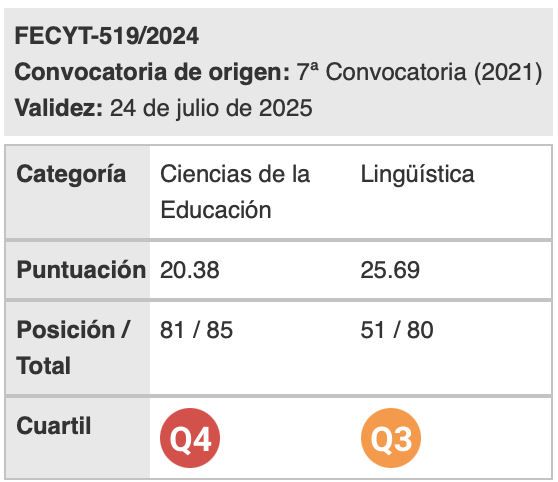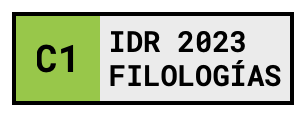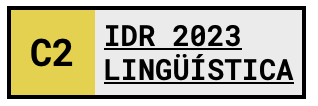A linguistic analysis of the dominant axiological values in Moroccan drink brand names
Palabras clave:
valores axiológicos, operaciones cognitivas, multimodalidad, nombre de marcaResumen
Los diseñadores de marcas suelen hacer uso, consciente o inconscientemente, de operaciones cognitivas para transmitir valores positivos a los nombres de marcas. Este artículo pretende estudiar los valores axiológicos más destacados en los nombres de marcas de bebidas marroquíes y cómo se introducen a través de operaciones cognitivas tales como las metáforas de comparación, las metáforas de correlación, las metonimias de expansión, las metonimias de reducción y las cadenas metonímicas. Además, mostraremos los modos verbales o visuales en las que se manifiestan. Para ello, hemos seleccionado un corpus de dichas marcas de la Office Marocain de la Propriété Industrielle et Commerciale (OMPIC). Este trabajo se ha estructurado según la Teoría Cognitiva de la Metáfora y la Metonimia (Lakoff & Johnson 1980, 1999; Ruiz de Mendoza & Pérez, 2011) y se ha extendido a la semántica axiológica (Krzeszowski 1997, 2004) y al discurso especializado (Felices Lago, 1996, 1999, 2002; Koller, 2009 entre otros). Con este estudio daremos cuenta de los medios cognitivos utilizados para denotar valores vinculados a esta categoría de producto.
Descargas
Citas
Aaker, D. (1996). Building Strong Brands. New York: Free Press.
Armstrong, G. & Kotler, P. (2018). Principles of Marketing. (17th ed.) Pearson education limited: United Kingdom.
Azzahraa El Yamlahi, F. (2021). A cognitive-axiological approach to anglicized Moroccan brand names. (PhD Dissertation). Almería: Universidad de Almería.
Azzahraa El Yamlahi, F. & Cortés de los Ríos, M ª E. (2022). Examining the metonymic relation between a brand name and a product: A case study of Moroccan cosmetic brand names. Ibérica 44, 391-416. https://doi.org/10.17398/2340-2784.44.391
Bhatti,A., Shafique, S. & Hameed, A. (2022). A linguistic analysis of the ecological claims in advertising discourse from axiological perspective. Journal of Tianjin University Science and Technology 55, 326-342.
Cortés de los Ríos, M.ª E. (2001). Nuevas perspectivas lingüísticas en la publicidad impresa anglosajona. (PhD Dissertation). Almería: Servicio de Publicaciones de la Universidad de Almería. ISBN: 84- 8240-390-7.
Diehl, S., Terlutte, R. & Mueller, B. (2015). Doing good matters to consumers. International Journal of Advertising, 4, 1-29.
Felices Lago, A. (1991). El componente axiológico en el lenguaje. Su configuración en los adjetivos que expresan emociones y conducta en la lengua inglesa. (PhD Dissertation). Granada: Universidad.
Felices Lago, A. (1996a). Axioematic analysis of brand names in English: A semantic-pragmatic approach to branding. In G. Budin (ed.), Multilingualism in Specialized Communication (Proceedings of the 10th European Symposium on Language for Special Purposes). Viena-Infoterm (pp. 991-1010).
Felices Lago, A. (1996b). Trade Names for Food and Drink: An Axioematic Analysis from a Diachronic Perspective. In J. Pérez Guerra (ed.), Proceedings of the XIXth International Conference of AEDEAN. Vigo: University Press (pp. 269-274).
Felices Lago, A. (1999). Axiological Linguistics Applied to Branding: Analysis of Trade Names Related to Personal Care, Cloth and Footwear. Unesco Alsed-LSP Newsletter 22(2), 16–27.
Felices Lago, A. (2002). Axiological analysis of brand names related to drugs, tobacco, domestic and household appliances. En M. González, E. Tenorio, N. McLaren y G. Porte (Eds.), A life in words a miscellany celebrating twenty-five years of association between the English Department of Granada University and Mervyn Smale, (1977-2002) (pp. 169-180). Universidad de Granada: Editorial de Universidad de Granada.
Felices Lago, Á. & Cortés de los Ríos, M.ª E. (2009). A cognitive-axiological approach to print-eco-advertisements in The Economist: The energy sector under scrutinity. Revista de Lingüística y Lenguas Aplicadas, 4, 59- 78.
Forceville, C. (1996). Pictorial Metaphor in Advertising. New York: Routledge.
Forceville, C. (2009). Metonymy in Visual and Audiovisual Discourse. In E. Ventola y J. Moya (Eds.), The World Shown: Multisemiotic Issues (pp. 56-74). London: Palgrave Macmillan.
Forceville, C. (2012). Creativity in pictorial and multimodal advertising metaphors. Discourse and Creativity, 113-132.
Forceville, C. & Urios-Aparisi, E. (2009). Multimodal Metaphor. Berlin and New York: Mouton-de Gruyter.
García Castillo, J. F. (2004). Metonymy and thought: verifying Ruíz de Mendoza & Otal's model of metonymy (a corpus-driven research). Jornades de Foment de la Investigació, 1-14.
Goossens, L. (1995). Metaphtonymy: The Interaction of Metaphor and Metonymy in Figurative Expressions for Linguistic Action. En L. Goossens, P. Pauwels, B. Rudzka-Ostyn, y A. Simon- Vanderbergen (Eds.), By Word of Mouth: Metaphor, Metonymy and Linguistic Action in a Cognitive Perspective (pp. 159–74). Amsterdam: John Benjamins Pub. Co.
Grady, J. (1999). A typology of motivation for conceptual metaphor. En R.W. Gibbs y G.J. Steen (Eds.), Metaphor in Cognitive Linguistics, (pp. 79-110). Amsterdam: John Benjamins
Hidalgo-Downing, L. & Kraljevic-Mujic, B. (2011). Multimodal metonymy and metaphor as complex discourse resources for creativity in ICT advertising discourse. Review of Cognitive Linguistics 9(1), 153-178.
Kahle, L. (1986). Social values and consumer behavior: Research from the list of values. En C. Seligman, J. Olson y M. Zanna, (Eds), The Psychology of Values: The Ontario Symposium (pp. 135-151). Mahwah, NJ: Lawrence Erlbaum Associates.
Kashanizadeh, Z. & Forceville, C. (2020). Visual and multimodal interaction of metaphor and metonymy: A study of Iranian and Dutch print advertisements. Cognitive Linguistic Studies, 7(1), 78-110.
Keller, K. L. (2003). Strategic Brand Management: Building, Measuring, and Managing Brand Equity. England: Pearson
Koller, V. (2009). Brand images: Multimodal metaphor in corporate branding messages. In C. Forceville & E. Urios-Aparisi, (Eds.), Multimodal metaphor (pp. 45-71). Berlin and New York: Mouton-de Gruyter
Koschate-Fischer, N., Diamantopoulos, A. & Oldenkotte, K. (2012). Are consumers really willing to pay more for a favorable country image? A study of country-of-origin effects on willingness to pay. Journal of International Marketing, 20(1), 19-41.
Krzeszowski, T. (1990). The axiological aspect of idealized cognitive models. In J. Tomaszczyk & B. Lewandowska (Eds.), Meaning and Lexicography (pp. 135-165). Amsterdam: John Benjamins.
Krzeszowski, T. (1993). The axiological parameter in preconceptual image schemata. In R.A. Geiger y B. Rudzka-Ostyn (Eds.), Conceptualizations and mental processing in language (pp. 307-330). Berlin: Mouton de Gruyter.
Krzeszowsky, T. (1997). Angels and Devils in Hell. Elements of Axiology in Semantics. Warszawa: Energeia
Krzeszowski, T. (2004). Metaphors of discourse: Between co-operative and oppositional discourses. In A. Duszak & U. Okulska (Eds.), Speaking from the Margin. Global English from a European Perspective, (pp. 107-116). Frankfurt: Peter Lang.
Lakoff, G. & Johnson, M. (1980). Metaphors we Live By. Chicago: The University of Chicago Press.
Lakoff, G. & Turner, M. (1989). More than Cool Reason: A Field Guide to Poetic Metaphor. Chicago: University of Chicago.
Lakoff, G. & Johnson, M. (1999). Philosophy in the Flesh: The Embodied Mind and its Challenge to Western Thought. New York, basic books.
Negro Alousue, I. (2014). Visual wine metaphor and metonymy in ads. Procedia - Social and Behavioral Sciences 173: 125-131. 32nd International Conference of the Spanish Association of Applied Linguistics (AESLA): Language Industries and Social Change. 3-5 April 2014, Seville.
Panther, K., Thornburg,L. & Barcelona, A. (2009). Metonymy and Metaphor in Grammar. Amsterdam: John Benjamins.
Paradis, C. (2000). Reinforcing adjectives: A cognitive semantic approach on grammaticalization. In R. Bermudez-Otero, D. Denison, R. M. Hogg, & C. B. McCully (Eds.), Generative theory and corpus studies (pp. 233–258). Berlin and New York: Mouton de Gruyter.
Pauwels, P. & Simon-Vanderbergen, A. (1993). Value judgement in the metaphorization of linguistic action. In R. Geiger & B. Rudzka- Ostyn (Eds.,), Conceptualizations and Mental processing in Language, (pp. 331-367). Berlin: Mouton de Gruyter.
Pérez Hernández, L. (2011). Cognitive tools for successful branding. Journal of Applied Linguistics, 32, (4), 369–388.
Pérez Hernández, L. (2013). A pragmatic-cognitive approach to brand names: A case study of Rioja wine brands. Names. A Journal of Onomastics 61(1), 33–46.
Pérez Hernández, L. (2019). XL burgers, shiny pizzas, and ascending drinks: Primary metaphors and conceptual interaction in fast food printed advertising. Cognitive Linguistics, 30(3), 531-570.
Pérez Sobrino, P. (2016). Multimodal metaphor and metonymy in advertising: A corpus-based account. Metaphor and Symbol, 31(2), 73-90.
Pérez Sobrino, P. (2017). Multimodal Metaphor and Metonymy in Advertising. John Benjamins Publishing Company.
Pollay, R. (1990). Advertising and Cultural Values: Reflections in the Distorted Mirror. International Journal of Advertising, 9(4), 359-372.
Pragglejaz Group (2007). MIP: A method for identifying metaphorically used words in discourse. Metaphor and Symbol 22, (1): 1-39.
Ruiz de Mendoza, F. J. (2011). Metonymy and cognitive operations. In R. Benczes, A. Barcelona, & F. J. Ruiz de Mendoza (Eds.), Defining Metonymy in Cognitive Linguistics Towards a consensus view (pp, 45-76). Amsterdam/Philadelphia: John Benjamins.
Ruiz de Mendoza, F.J. & Peña, S. (2005). Conceptual interaction, cognitive operations and projection spaces. In F. J. Ruiz de Mendoza & S. Peña (Eds.), Cognitive linguistics: Internal dynamics and interdisciplinary interaction (pp. 254–280). Berlin and New York: Mouton de Gruyter.
Ruiz de Mendoza, F. J. & Pérez Hernández, L. (2011). The Contemporary Theory of Metaphor: Myths, Developments and Challenges. Metaphor and Symbol 26,(3), 161-185.
Ruiz de Mendoza, F. J. & Galera Masegosa, A. (2014). Cognitive Modeling: A linguistic Perspective. Amsterdam/Philadelphia: John Benjamins.
Sperber, D. & D. Wilson. (1995). Relevance: Communication and Cognition (2nd ed.). Blackwell Publishing.
Steen, G. J., Dorst, A. G., Herrmann, J. B., Kaal, A. A., Krennmayr, T., & Pasma, T. (2010). A method for linguistic metaphor identification. From MIP to MIPVU. Amsterdam: John Benjamins.
Tsai-Feng, K, & Yi-Zhan, D. (2020). A study on the influence of green advertising design and environmental emotion on advertising effect. Journal of Cleaner Production, 1-13.
Villacañas, B. & White, M. (2013). Pictorial metonymy as creativity source in Purificación García advertising campaigns. In L. Hidalgo y B. Kraljevic (Eds.), Metaphorical creativity across modes: Special issue of Metaphor and the Social World, 3, (2), 220–239. Amsterdam/Philadelphia: John Benjamins.
Wood, L. (2000). Brands and brand equity: definition and management. Management Decision, 38, (9), 662-669. https://doi.org/10.1108/00251740010379100
Zaltman, G & Zaltman, L. H. (2008). Marketing Metaphoria: What Deep Metaphors Reveal About the Minds of Consumers. Harvard Business Press.
Zeng, W. H. (2019). A Cognitive-pragmatic Approach to Metaphor and Metonymy in Brand Names: A case Study of Film Titles. Taiwan Journal of Linguistics, 17(1), 01-47.
Descargas
Publicado
Cómo citar
Número
Sección
Licencia
Aquellos autores/as que tengan publicaciones con esta revista, aceptan los términos siguientes:
- Los autores/as conservarán sus derechos de autor y garantizarán a la revista el derecho de primera publicación de su obra, el cuál estará simultáneamente sujeto a la Licencia de reconocimiento de Creative Commons que permite a terceros compartir la obra siempre que se indique su autor y su primera publicación esta revista.
- Los autores/as podrán adoptar otros acuerdos de licencia no exclusiva de distribución de la versión de la obra publicada (p. ej.: depositarla en un archivo telemático institucional o publicarla en un volumen monográfico) siempre que se indique la publicación inicial en esta revista.
- Se permite y recomienda a los autores/as difundir su obra a través de Internet (p. ej.: en archivos telemáticos institucionales o en su página web) antes y durante el proceso de envío, lo cual puede producir intercambios interesantes y aumentar las citas de la obra publicada. (Véase El efecto del acceso abierto).

Revista de Lenguas para fines específicos is licensed under a Creative Commons Reconocimiento-NoComercial-SinObraDerivada 4.0 Internacional License.























